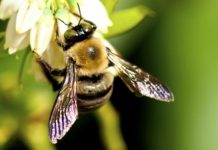
July 10 (UPI) — Researchers found in a recent study that spider silk partially yields when twisted, which prevents rappelling spiders from spinning out of control.
The study, published in the July edition of Applied Physics Letters, showed that, unlike human hair, metal wires or synthetic fibers, spider silk partially yields when twisted to resist spinning.
“Spider silk is very different from other, more conventional materials,” Dabiao Liu of Huazhong University of Science and Technology, said in a press release. “We find that the dragline from the web hardly twists, so we want to know why.”
Spiders use dragline silk for the outer rim and spokes of their webs as well as a lifeline for dropping to the ground.
Researchers used a torsion pendulum to investigate dragline silk from two species of golden silk orb weaver spiders by collecting strands of silk from captive spiders. They suspended the strands inside a cylinder with two washers to mimic a spider.
The cylinder was able to isolate the silk from environmental disturbances and keep it at a constant level of humidity. The researchers then used a rotating turntable to twist the silk while a high-speed camera recorded the silk’s movements over hundreds of cycles.
Researchers found spider silk deforms slightly when twisted to release more than 75 percent of its potential energy and rapidly slow the oscillations. When the twisting process is over, the silk partially snaps back.
The researchers theorize that the ability of the silk to yield is due to its complex structure, which consists of a core of multiple fibrils inside a skin that are made up of amino acids in organized sheets and others in unstructured looping chains.
“There is a lot of further work needed,” Dunstan said. “This spider silk is displaying a property that we simply don’t know how to recreate ourselves, and that is fascinating.”





